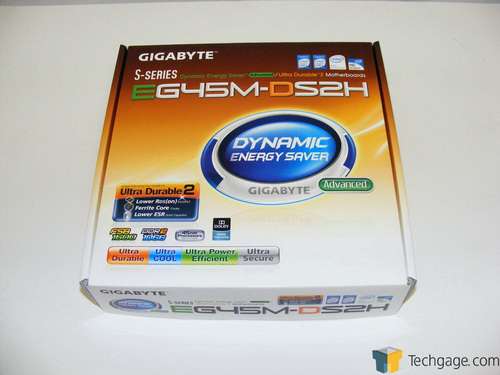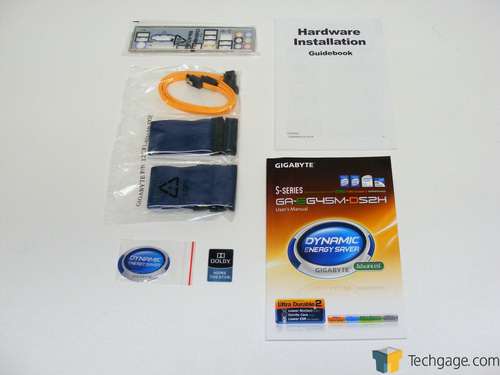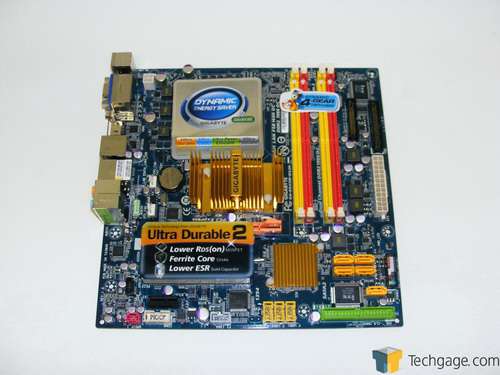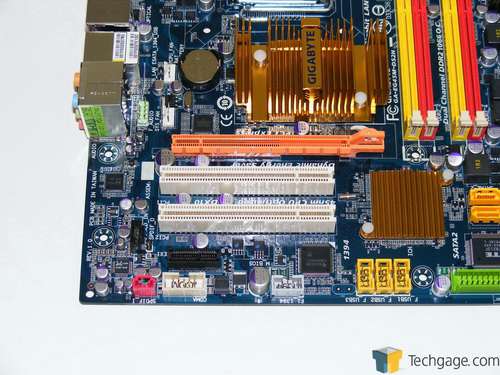- Qualcomm Launches Snapdragon 4 Gen 2 Mobile Platform
- AMD Launches Ryzen PRO 7000 Series Mobile & Desktop Platform
- Intel Launches Sleek Single-Slot Arc Pro A60 Workstation Graphics Card
- NVIDIA Announces Latest Ada Lovelace Additions: GeForce RTX 4060 Ti & RTX 4060
- Maxon Redshift With AMD Radeon GPU Rendering Support Now Available
Gigabyte EG45M-DS2H
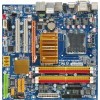
On the test bench today, we have Gigabyte’s latest Micro ATX offering, the Intel G45-based EG45M-DS2H. This board carries the typical Gigabyte enthusiast charm, but also caters towards those looking to build a media center. But how does it stack up against the other Intel mATX boards we’ve tested recently?
Page 2 – First Impressions
Like just about everything else out there, Gigabyte’s EG45M-DS2H came to us in a glossy, colorful box that touts the product’s features, the Gigabyte board’s Dynamic Energy Saver feature foremost among them. While it’s unlikely that choosing an energy-efficient motherboard will have any effect at all on performance, the fact that you can use the EG45M-DS2H as the platform for an energy-efficient PC may be appealing to the value-oriented crowd, as well as anyone who tends to leave their computer on for weeks at a time.
Here’s what you get with the EG45M-DS2H motherboard bundle: You get the board itself, a comprehensive user’s manual, a helpful multilingual “Hardware Installation Guidebook” that details the process of hardware installation into the motherboard in step-by-step form for first-time builders, a customized I/O panel, a pair of locking serial-ATA cables, ribbon cables for your floppy (if present) and parallel-ATA drives, and a set of stickers, including a Dolby Home Theater sticker (a nice touch if you’re building a HTPC) and an enormous “DYNAMIC Energy Saver” sticker. While we can’t personally imagine being enthusiastic enough about energy savings alone to affix the monstrous Dynamic Energy Saver sticker to our case, the hardware bundle overall reflects Gigabyte’s orientation as a manufacturer toward system builders of all skill levels. In fact, we can’t think of anything they’ve left out.
The board itself ships with several decals affixed to it, which you’ll need to remove if you want to make any progress installing hardware components. Thankfully, the decals come off easily, but we’d honestly rather keep the marketing materials on the box, not the board itself.
The board is also brightly colorful, with Gigabyte’s signature blue PCB and gold-anodized heatsinks, as well as multi-colored ports, plugs, and jacks. Even though it’s a value board, Gigabyte is obviously still intimately familiar with many enthusiasts’ desire to show off their handiwork. Let’s look at a breakdown of the EG45M’s specifications.
-
EG45M-DS2H Specifications
- CPU Socket: LGA 775 (Intel)
- CPU Support: Core 2 Duo/Quad/Extreme, Pentium Dual-Core, Celeron
- Chipset: Intel G45 Express featuring G45 GMCH Northbridge, ICH10R Southbridge
- Onboard Graphics: Onboard Intel GMA X4500HD in G45 GMCH
- Memory: 4x 1.8V DDR2 DIMM sockets, supports up to 16GB, DDR1066, dual channel
- Audio: Realtek ALC889A High Definition Audio, up to 7.1, supports Dolby Digital, S/PDIF output
- LAN: Realtek 8111C (10/100/1000 Mbit)
- Expansion Slots: 1x PCI Express 2.0 x4, 1x PCI Express x1, 2x PCI
One of the more important pieces of information we can glean from the board’s specifications is also so subtle that you might miss it if you weren’t looking for it. The EG45M-DS2H’s larger PCI Express 2.0 slot looks like a typical 16x PCI Express slot, but only four lanes are active – giving only one-fourth the available bandwidth of a true x16 slot. The PCI Express specification calls for the X16 connector to be used for all applications greater than x2, so the board is still fully standards-compliant, but you couldn’t tell that the slot was only a 4x slot simply by looking at it.
Why do this, when the G45 chipset has 16 available PCI Express 2.0 lanes? On a typical IGP motherboard, those 16 available lanes are either allocated to the IGP or the active GPU, but never both. Gigabyte’s unorthodox arrangement allows the G45’s integrated GMA X4500HD graphics core to claim all of the 16 available lanes, while the additional 4 lanes are provided by the ICH10R southbridge, allowing both video processors to be active at once, driving multiple displays.
However, the highest-end video cards of today might stretch that available bandwidth to its limit, so you probably wouldn’t want to consider the EG45M-DS2H if you’re planning on upgrading to an NVIDIA GeForce GTX 280 anytime soon. But if you’re satisfied with a midrange video card, you’re probably good to go. And honestly, for a productivity-oriented workstation or a home theater PC that won’t be tasked with any gaming at all, a midrange video card is quite enough for all but the most specialized workloads (like hardware-accelerated image editing or 3D modeling programs).
Next, let’s delve into the Gigabyte EG45M-DS2H’s layout.
Support our efforts! With ad revenue at an all-time low for written websites, we're relying more than ever on reader support to help us continue putting so much effort into this type of content. You can support us by becoming a Patron, or by using our Amazon shopping affiliate links listed through our articles. Thanks for your support!




